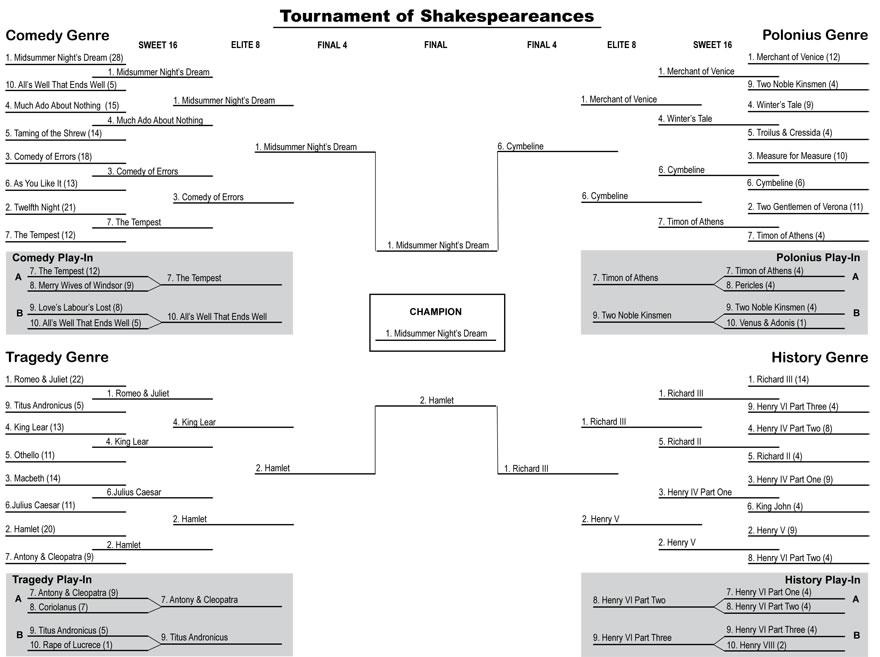A Tournament of Shakespeareances
The Final: Titles Tilt for the Title
It's A Midsummer Night's Dream, the tournament's top seed with 28 stage productions, versus Hamlet, the Tragedy bracket's second seed with 20 stage productions. We play out this Tournament of Shakespeareances final in a five-act contest that comes down to the final play.
Act One
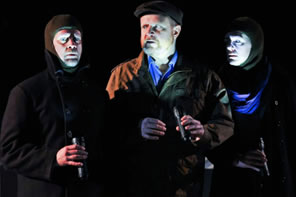
From left, Bernardo (Tom O'Keefe), Horatio (Edmund Lewis), and Marcellus (Andrus Nichols) keep watch in the Bedlam production of Hamlet. Photo by Jenny Anderson, Polk & Co.
Hamlet scores right from the tip-off: "What, has this thing appear'd again to-night?" Soldiers standing guard on a cold, dark night, and before one of them even has the chance to describe "this thing," it appears: a ghost in armor whom we learn is King Hamlet, deceased father of the play's titular prince. The four-actor Bedlam production opens with a totally dark theater and three actors carrying flashlights; the ghost's appearance is a heart attack moment.
A Midsummer Night's Dream has trouble scoring at the outset: "Now, fair Hippolyta, our nuptial hour draws on apace; four happy days bring in another moon." Four days is not "apace" in a theater space, and Theseus's alleged impatience is suddenly trumped with a whopper of an enigmatic speech less than 20 lines into the play: "Hippolyta, I woo'd thee with my sword, and won thy love, doing thee injuries; but I will wed thee in another key, with pomp, with triumph and with reveling." WTF? In the 1935 Max Reinhardt film, Verree Teasdale's Hippolyta appears to be physically wounded—and none too happy—while Ian Hunter as Theseus hovers in leeringly, obviously not wanting to wait four days.
Dream stumbles on. Egeon approaches Theseus with his daughter, Hermia, her boyfriend Lysander, and his rival, Demetrius, who is Egeon's choice of husband for Hermia instead of Lysander. So adamant is Egeon about this that he demands that Theseus doom her to death if she doesn't acquiesce. Foul! Theseus shows some leniency by offering, as an alternative, a life of celibacy in a convent. Foul! Although this passage has a funny line from Lysander—"You have her father's love, Demetrius; let me have Hermia's: Do you marry him"—it's difficult for actors to know whether to play this matter as straight and unfunny or skew it somehow. The Shakespeare Forum production deliberately makes these initial Athenian scenes unfunny, noting that this play focuses on hate as much as it does on love.
Lysander and Hermia hang around for several lines cursing their fate—a passage several productions cut—before Lysander proposes to elope with Hermia via the woods outside of Athens. Helena shows up, Hermia's best friend and in love with Demetrius (who, for whatever reason—guys being guys—once loved Helena but now despises her) and Hermia tells Helena of the elopement plans. After the loving couple leave, Helena determines to rat them out to Demetrius. Why? So he can chase after them and she can chase after him, and the only thing that makes sense in all this for our purposes is that Dream is faltering big time while Hamlet continues building up dramatic pressure.
Hamlet's second scene moves to the court of Claudius, Hamlet's uncle, and Gertrude, Hamlet's mother, who are now married: Foul! We also finally see the title character himself, dressed in black and sulking. In the middle of this scene is the first of Hamlet's great soliloquies, "O, that this too too solid flesh would melt, thaw, and resolve itself into a dew!" What makes Hamlet such great literature is, in large part, Hamlet's seven soliloquies; whether it makes for great theater is all in the hands of the actor playing the part, and even without the rest of the play, Derek Jacobi creates riveting theater with his soliloquies in the BBC/Time-Life production.
Horatio tells Hamlet of the ghost, a passage the American Shakespeare Center's (ASC) 2011 production used to firmly establish the comedy thread, aside from Hamlet's quips, running through the play. When John Harrell's meditating Hamlet remarks, "My Father!—methinks I see my father," Patrick Midgley's Horatio and the two guards accompanying him switch into alert mode with "Where, my lord?" A bemused Hamlet replies, "In my mind's eye, Horatio." Then, Horatio hogs the recounting of encountering the ghost, furthering the guards' irritation with him that began back on the battlements when Horatio believed the ghost was nothing but their fantasy.
The play shifts to the Polonius family, young Laertes taking his leave of Ophelia (take care if you are in the splash zone of Andrus Nichols's tears falling to the floor as she plays Ophelia in the Bedlam production). Laertes is then encountered by Polonius, who lays on his son "these few precepts." Ted van Griethuysen in a landmark 1992 Shakespeare Theatre Company (STC) and reprised in van Griethuysen's one-man reading of the entire play last year reconciles the comedy elements of the man with his role as a doting father and loyal counselor to the king. His culpability in the court intrigue is tempered by the fact that he has no idea that Claudius had killed the elder Hamlet.
And now the younger Hamlet learns that fact—or he believes he learns that fact—from the Ghost itself. Actors love playing the Ghost because of its mighty lines, though the Faction of Fools commedia dell'arte production, Hamlecchino, Clown Prince of Denmark, infuses the speech with the comedy of an old man wandering off into tangents. In the ASC 2011 production, René Thornton Jr. reins in the mighty verse to something felt internally, speaking the usually ear-shattering lament of “O horrible, O horrible, most horrible!” in a soft tone of deep, deep pain.
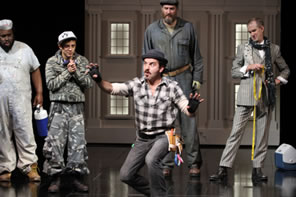
From left, Jacob Ming-Trent, Zachary Infante, Max Casella, Brendan Averett, and William Youmans as Rude Mechanicals. Photo by Gerry Goodstein, Theatre for a New Audience.
After its opening scene in Duke Theseus's court, Dream takes a time-out and resumes play with an entirely different lineup. Replacing the Athenian court nobles is a bunch of what have become widely known as the Rude Mechanicals. Peter Quince, an amateur theater impresario, has gathered five of his fellow tradesmen to cast parts for the play Pyramus and Thisbe that they intend to present at Theseus's wedding. Every time van Griethuysen enters as Quince in the STC 2012 production he's singing to himself an old Broadway show tune, always pertinent to the emotion of that particular scene. In the Julie Taymore's Theatre for a New Audience (TFANA) 2013 production, the Rude Mechanicals are stagehands. Emerging as the leader of this group is Bottom, a comic actor's dream part from the time Will Kemp originated the role in Shakespeare's company. This scene fully establishes the comic tone of Dream, especially in Synetic Theater's Silent Shakespeare production in which the Rude Mechanicals are reminescent of pantomiming silent film slapstick comedians, complete with on-stage piano soundtrack.
The Rude Mechanicals finally gets Dream on the scoreboard, but the first act ends with Hamlet heading for a blowout.
Act Two
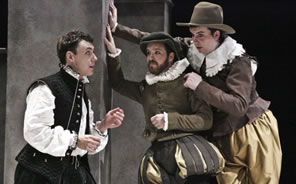
Hamlet (John Skelley), Rosencrantz (Grant Fletcher Prewitt), and Guildenstern (Ian Gould) in The Acting Company's production of Tom Stoppard's Rosencrantz and Guildenstern Are Dead. Photo by Michael Lamont, Guthrie Theater.
However, Hamlet goes into a stall. Polonius sends a servant to not only spy on Laertes but spread ill rumors about him (a scene often cut), and then Ophelia comes in describing Hamlet acting crazy. The act's second of two scenes moves to another location in the court, where Claudius and Gertrude greet Rosencrantz and Guildenstern, allegedly old school buddies of Hamlet. Pairing Hamlet in repertory with Tom Stoppard's Rosencrantz and Guildenstern Are Dead, The Acting Company in 2014 had Rosencrantz flipping a coin as he enters the first time, and in the four-actor Bedlam version, all four actors fill both roles, playing up the traditional notion that the two characters are indistinguishable. Polonius arrives to tell Gertrude and Claudius that Hamlet is mad for love and reads one of the prince's letters to Ophelia. Polonius sticks around to talk with Hamlet, a funny scene full of non sequiturs and possible riddles, then Rosencrantz and Guildenstern arrive for more riddling matter and to tell Hamlet of the players who have come to Elsinore. The players arrive, we get a speech from the First Player (which can be the highlight of the entire play in such performances as René Thornton Jr. at ASC in 2011). Everybody leaves Hamlet alone, he calls himself a rogue and peasant slave, and he determines to use a play to catch the conscience of the king.
While Hamlet is puttering around with words, words, words, Dream takes yet another time-out and, though the Rude Mechanicals had gotten the play on a roll, onto the stage comes yet a third completely new lineup: the fairies. Specifically, we are introduced to Oberon and Titania, the king and queen of the fairies, and Oberon's henchman, Puck. Oberon and Titania are fighting over a changeling Indian boy, a reference that can seem so confusing that some productions insert an actual boy into the action (Reinhardt's film, STC), though Shakespeare did not—seeing the device used in those productions, we can appreciate Shakespeare's wisdom to keep the boy offstage.
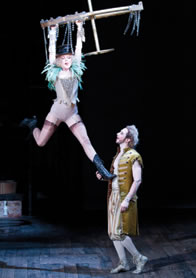
Nancy Anderson as First Fairy and Adam Green as Puck in the Shakespeare Theatre Company's A Midsummer Night's Dream. Photo by Scott Suchman, Shakespeare Theatre Company.
Though the scene opens with long expository speeches—the first one describing Puck, the second one Titania recounting the argument with her husband and its effects on fairyland—the fact that fairies have taken over the stage scores big. I've seen fairies sexy, from a shirtless Patrick Stewart in his prime (Royal Shakespeare Company 1977) to a genie-clad Stephanie Holiday Earl (ASC 2011). I've seen fairies fantastical, from Titania with seven-foot-long gossamer fairy wings (Chesapeake Shakespeare Company) to the royal couple walking on stilts (Shakespeare Theatre of New Jersey). I've seen fairies represented by giant masks and hands (Bristol Old Vic/Handspring Puppet Company) and as carnival and circus characters (Clever by Half, STC). And I've seen cross-dressing fairies: ASC in 2004 doubling Theseus with Titania and Hippolyta with Oberon, and Stratford Festival switching Oberon and Titania in alternating shows.
This scene continues with Oberon determining to put Titania under a spell with a love potion from a flower that will make her dote on the first thing she sees. However, Oberon encounters Helena chasing Demetrius, searching for Hermia and Lysander. This passage can send Dream off the rails, thanks to Helena's self-abusing language and Demetrius threatening to rape her though he hates her (and she wanting it; Emily Whitworth's Helena even invitingly spread her legs in the Synatic Theatre production). Many productions aim to excuse Helena by making her bipolar or an ironic intellectual. But Madeline Wise in the Millbrook Playhouse production proves this and Helena's subsequent scenes make for great comedy when played true to the text as a stubbornly persistent, besotted young woman opposite an exasperated Demetrius.
The second scene of this act gets the real magic going: Oberon casts a spell on a sleeping Titania, and Puck mistakenly casts a spell on the sleeping Lysander, who awakes to Helena kneeling over him and instantly falls in love with her, his love for Hermia turning to hate. Shakespeare is using a lot of moving parts in his long-range strategy with Dream so that we know something's coming but can in no way guess correctly just what.
Thus, by the end of Act Two, Dream is closing the gap with Hamlet.
Act Three
Dream opens with another lineup change, putting the Rude Mechanicals back on stage—but they are not alone. They are now in the woods to rehearse their play, trying to figure out how to get such props as moonshine and a wall, required in their play, into the Duke's chambers. Jacob Ming-Trent as Snout in the TFANA production, who has been drinking beer and sitting in a mossy easy chair, jumps up and with such common-sense incredulity says "Jesus Christ, you can never bring in a wall!" Bruce Dow in the STC version brings the house down as a prima donna Bottom who goes through affected consternation willing himself back into the character of Pyramus when Quince corrects his line reading.
The mechanicals happen to be near Hippolyta's bower, so when Puck shows up, he transforms Bottom and one of the most iconic of Shakespeare's images appears on stage, the ass-headed Bottom, a moment which seldom fails to generate a big laugh. The Bristol Old Vic/Handspring Puppet Company production turns this famous image, literally, on its head by turning Miltos Yerolemou, wearing a tasseled skullcap and funny shoes, upside down on a cart so that his rear-end becomes Bottom's face with his shoes as donkey ears and his cap as a donkey's tail. Titania literally falls in love with an ass.
Hamlet has no answer to that shot, and Dream surges into the lead. The Quarto version of Hamlet, that most actors I've talked to prefer, moves through more court intrigue as Claudius and Polonius plant Ophelia in Hamlet's way to sound him out (the First Folio version, though, takes a circuitous route through these sequences). The result is Hamlet railing at Ophelia to get to a nunnery. Poor Ophelia and almost any actress playing her navigating a character enduring these bewildering events. Miriam Donald in the 2011 ASC production plays Ophelia as a strong, young woman in the tradition of Viola and Rosalind, bravely withstanding Hamlet's assault but breaking down in the end seeing "what a noble mind is here o'erthrown.”
In the middle of all this is the greatest literary highlight reel of the second millennium (perhaps second only to "I have a dream"), Hamlet's "To be or not to be" soliloquy. The problem is, many actors approach this speech with a desire to somehow make it different from the billions of performances that have preceded them. Sometimes we get cute substitutes, like Matthew Gregor in a 1994 Wright State University production spray painting "2B" in a circle on the wall, then spray painting a line through it. Some actors rush into the speech to beat the audience mouthing along, others try to wait out the audience's anticipation. Patrick Earl in the current ASC touring production easily, smoothly, asks that famous question and speaks the next 32 lines trippingly on the tongue, suiting the action to the words, never overstepping the modesty of nature. So simple, so perfect, and yet so Hamlet.
It turns the tide for Hamlet, and as the tragedy returns to early form, this match becomes a shootout to the end of the third act.
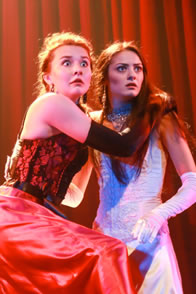
Emily Whitworth as Helena, left, and Irina Kavsadze as Hermia in Synetic Theater's A Midsummer Night's Dream.. Photos by Johnny Shryock, Synetic Theater.
Dream moves into its crux scene of the lovers's battle royale, as Demetrius gets a dose of love potion and now both he and Lysander are rivals for Helena's love instead of Hermia's, and the two longtime girlfriends turn on each other, as well. This scene can get bogged down with Helena now whining over-much that everybody is using her as the butt of an elaborate joke while Hermia takes forever to catch on to Lysander's change of heart. But when Hermia does catch on and immediately blames Helena, this scene gets fun: in the 2011 ASC touring production before a school group matinee, the students "oooooohh" as one when Hermia calls Helena a "painted maypole." At least a quarter of the productions I've seen get the lovers down to their underwear, so you've got the prurient factor at least, and the STC production even mixes in mud wrestling while Synetic's production features an out-and-out catfight. But when the lovers are skilled verse speakers and the choreography sharp, this scene can be the play's comic highlight, too, as we've seen at the Millbrook Playhouse, and the Stratford Festival. And don't forget that Oberon and Puck are watching the whole while, which can add a comic element in their reactions, with or without their eating popcorn, as in the STC production before Adam Green's Puck intervened with the mud.
Hamlet, meantime, comes on strong, with the Mousetrap, the play within the play portraying the circumstances of the elder Hamlet's murder so that Hamlet and Horatio can watch Claudius's reaction. This can be cumbersome theatrically, but when cleverly enacted it is a keen piece of drama, as was the case with the Shakespeare's Globe touring production at the Folger Theatre, which, through stagecraft, had Dickon Tyrrell doubling as Claudius and the Player King, and Miranda Foster as Gertrude and the Player Queen, and we get Claudius's reaction to the play through the expression of Horatio (Tom Lawrence, who also doubles as the Player Clown). The BBC/Time-Life version filmed the scene in a single take with cameras focused on each of the various characters, their reactions edited in to the final product.
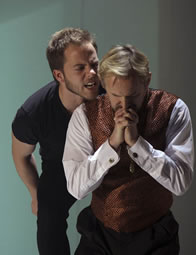
Graham Michael Hamilton as Hamlet contemplates killing the praying Claudius, played by David Whalen, in the Folger Theatre's production of Hamlet, before deciding doing so might send Claudius's soul to heavan. Photo by Carol Pratt, Folger Shakespeare Library.
After the guilty king roars off, Hamlet sows more confusion, including calling out Rosencrantz and Guildenstern to play on a pipe as they would play on him. Jonathan Hyde as Rosencrantz in the BBC/Time-Life production can no longer contain his superior attitude at this point and reveals just how much a sponge he really is. Two more scenes amp up the tension: Hamlet coming across Claudius praying and, instead of killing him there and then, holding off lest he send the king's soul to heaven as revenge for his father's murder; and then Hamlet accosting his mother in her bedchamber with the eavesdropping Polonius, whom Hamlet kills through the arras.
The moment of this murder can play as funny even as it sends Hamlet inexorably toward its tragic ending. At no other point in the play does Hamlet seem genuinely insane as he does here, and its a crux moment for the character. But don't forget Gertrude, and Andrus Nichols in the Shakespeare Forum production is unforgettable. Gertrude is already irritated with her son's bizarre staging of a play that angers her husband, that son storms in on her, becomes physically abusive, and then kills Polonius right in front of her. Even as Hamlet continues to rail at Gertrude, taking issue with her choice in men and having sex at her age, Polonius's dead body is still right there, and Nichols keeps glancing at it. Hamlet suddenly sees his father's ghost. Gertrude doesn't, and Nichols has her grappling with the clear evidence that Hamlet really is insane. It's a heart-wrenching moment, as Gertrude glances in threefold helplessness from son to Polonius' body and to vacant space occupied by the ghost.
Andrus scores big here, showing us Shakespeare at the height of his compositional powers and giving Hamlet the lead again after three acts.
Act Four
Having grabbed the lead, Hamlet switches gears and again goes into something of a stall. We get some sick humor as Hamlet obliquely tells the king to go to Hell and makes fun of Polonius's dead body before Claudius sends him off to England with Rosencrantz and Guildenstern in attendance (a trip from which they will not return). After another soliloquy, this time about the army of Norway's prince Fortenbras marching through Denmark on its way to battle with Poland—a scene that, at the time, seems to have no bearing on the plot and only serves the purpose for more Hamlet navel-gazing—Hamlet's title character disappears for the rest of the act.
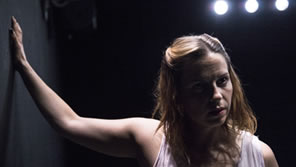
Kimberly GIlbert as Ophelia in her show Enter Ophelia, distracted at Taffety Punk. The one-character show, which Gilbert plays with three other actresses, gives the story of Hamlet through his disintegrating one-time girlfriend. Photo by Teresa Castracane, Taffety Punk.
Instead, the focus turns to Laertes, returning from Paris seeking revenge for his father's murder and "obscure funeral," and to Ophelia, now mad. This is another of this play's iconic moments, Ophelia with her flowers, but it's not an easy arc for the actress playing her—unless you make the arc itself the whole play, as Kimberly Gilbert does with Enter Ophelia, distracted for Taffety Punk, a one-character play (the other characters we can hear in voiceover) played by four actresses representing Ophelia's disintegration. This act also has Gertrude's famous speech recounting Ophelia's drowning, and in its commedia dell'arte rendition of the play, Faction of Fools puts aside the slapstick for a beautiful aerial ballet of Ophelia's death performed by Emma Crane Jaster.
Despite these famous moments and the political thriller plot advancing onward—we hear that Hamlet has been saved by pirates (?!) and returned to Denmark, and Claudius and Laertes hatch a convoluted plot to kill Hamlet without anybody knowing—the stage action loses steam. Polonius is gone, fouled out of the match too early, and Hamlet himself is on the bench in foul trouble. Without a dynamic Laertes (Kenneth Branagh in the 1985 RSC production is the most notable Laertes I've seen), even Rosencrantz and Guildenstern are missed.
Dream, on the other hand, steams along, especially in the Bristol Old Vic/Handspring Puppet Company production in which we see Titania, um, riding Bottom. With a great Bottom, this scene of fairy queen and ass-headed weaver ordering her fairy servants around is hilarious and full of sexual innuendo. Answering Titania's query of what he would “desirest to eat,” Rick Blunt's Bottom in the ASC 2011 production turns to the luscious lady and in a creepily seductive mode replies, “I could munch your good dry oats.”
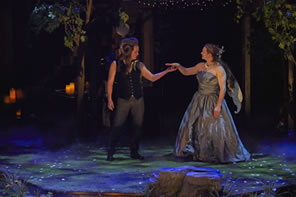
Evan Buliung, here as Oberon, and Jonathan Goad (Titania) alternated their roles during the run of Dream at Stratford Festival. Photo by Michael Cooper, Stratford Festival.
We learn that Oberon's prank on Titania has worked—fixated on Bottom she gladly gives over the changeling boy to Oberon—and he casts a reverse spell on her, awaking her to her old self, loving Oberon and loathing the sight of Bottom. This is obviously a misogynist moment from Shakespeare—or not, depending on how it is played. Saskia Portway as Titania, gets one of the night's biggest laughs in the highly entertaining Bristol Old Vic/Handspring Puppet Company production when she gives nary a reaction upon seeing Bottom's bottom with a clear eye before turning back to Oberon and asking with piercing suspicion, "How came these things to pass?" immediatly putting David Ricardo-Pearce's Oberon on the defensive.
Puck, meanwhile, reverses the love spell on Lysander and removes Bottom's ass's head. The lovers are awakened by Theseus and Hippolyta hunting, and as Demetrius professes his love for Helena (Jonathan Minton made this a perfect-chick-flick moment at Millbrook Playhouse), Theseus overrules his previous ruling on Hermia and invites both couples to join him and Hippolyta in a triple wedding. Bottom awakes and returns to his fellow rude mechanicals reporting that their play is preferred.
With one act to go, the score is tied. We know, however, that Hamlet has much dramatic firepower to come, whereas Dream seems to have already reached its happy ending. What can it do to keep up?
Act Five
Onto the stage of Hamlet walk two gravediggers. They tell some jokes, and one gets into the stage trapdoor to start digging and unearthing bones and skulls . Daniel Kennedy in the 2009 ASC touring production solicited help from Navy ROTC cadets sitting in the theater's front row, handing them tools and skulls and placing a cadet's flight cap on Yorick's skull. Alas, poor Yorick! Making his return to the play, Hamlet holding Yorick's skull is Hamlet's most famous iconic visual. You can't market Hamlet without Yorick, it seems. This famous soliloquy gives way to a funeral procession, which turns out to be that of Ophelia—the first that Hamlet learns she has died—and he ends up grappling with Laertes in her grave, fighting over who loved her most. Sounds ridiculous, doesn't it? Faction of Fools, in fact, turns this moment into a typically over-the-top slapstick punch-up in its commedia dell'arte production.
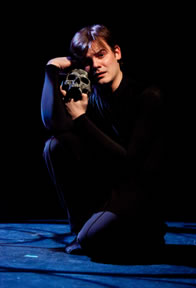
Alex Mills as Hamlet with Yorick's skull in Synetic Theater's Silent Shakespeare production of Hamlet. Photo by Koko Lanham, Synetic Theater.
After hour upon hour upon hour of delay, Hamlet now speeds toward its resolution: the climactic fencing bout, in which all the court attend a contest between Hamlet and Laertes, who has an unbated foil doused in poison. As a backup plan, Polonius has a chalice of poisoned wine at the ready. This scene is always suspenseful and, with some good combat choreography, truly exciting. Bedlam has only four actors to manage the whole thing, and they use different caps to distinguish the characters, so in addition to swords in a flurry of action, hats and caps are flying through the air as actors shift from one character to another.
Neither Laertes nor Claudius count on Hamlet being as good at fencing as he turns out to be, and Laertes has to cheat to strike the fatal blow, whereupon Hamlet gets hold of the poisoned sword and cheats Laertes of the rest of his life. Claudius also doesn't anticipate Gertrude drinking from the chalice. She dies, proclaiming she's been poisoned, Laertes confesses the whole plot, and Hamlet finally—finally—kills Claudius, then dies himself. "Now cracks a noble heart. Goodnight sweet prince, and flights of angels sing thee to thy rest," Horatio says, speaking the last of the play's many famous lines that have become non-contextual cliches. It is such great writing that makes this play worth its length.
Act Five of A Midsummer Night's Dream opens with Theseus telling Hippolyta about how "the lunatic, the lover, and the poet, are of imagination all compact." It's a great speech, thematically apt to the play and perhaps reflective of the playwright himself. Too bad too many productions cut it, desiring to get on with the Rude Mechanicals' staging of Pyramus and Thisbe for the couples as post-wedding/pre-honeymoon entertainment. Many productions cut down the next segment, too, Philostrate going over a list of entertainment options, including "The riot of the tipsy Bacchanals, tearing the Thracian singer in their rage." His list never fails to generate laughs, especially with Theseus's flippant dismissal of each; for example, about the tipsy Bacchanals, he says, "That is an old device, and it was played when I from Thebes came last a conqueror."
Directors have to keep in Philostrate's description of "A tedious brief scene of young Pyramus and his love Thisbe; very tragical mirth," for that introduces, exactly, what is to come. Philostrate tries to dissuade Theseus from choosing it by describing what he has seen in a rehearsal of the play. In the STC production, Adam Green as Philostrate speaks this with a twinkle in his eye, for he also plays Puck, who had witnessed the rehearsal in the woods before playing with Bottom's head. While doubling Duke Theseus's "manager of mirth" with King Oberon's maker of mirth is as common as doubling Theseus and Hippolyta with Oberon and Titania, STC's rendetion incorporates these transition into the play's action, reminding us how much Shakespeare blurs the lines of reality and theatrical imagination with A Midsummer Night's Dream.
With Pyramus and Thisbe, Shakespeare pokes fun at amateur theater and perhaps pokes fun at the insulting interjections from the lords. Many productions cut down on the lords' catcalls because they do seem so mean and could dilute the scene's overall humor. But if the Mechanicals remain totally oblivious (as Bottom obviously is) or respond in kind, it amps up the humor. In the ASC 2011 production, Ronald Peet as Flute enters as Thisbe to Hippolyta saying, "I hope she will be brief," and Peet gives her a withering look. The Beatles played this scene, and John Lennon's Thisbe gives as good as he takes from the lords. In a student production at Brooklyn Tech, Shawntel Gayle plays Moon with such a 'tude, he bounces the humor right back on the court's hecklers.
Nevertheless, it is the playing of the play itself that never fails to generate laughter—go ahead and click on any of my reviews of Dream and you will find this to be so, and two productions left me in tears I laughed so hard, the 1997 Atlanta Shakespeare Tavern's and the 2012 Shakespeare Forum's. Shakespeare's text gives actors so much to work with here, and directors' imaginations can fill in the visuals, especially in the presentations of Wall, Moonshine, and Lion, and marry the action to a whole host of potential puns in the script. And how many ways does Bottom's Pyramus die, based on the number of times he says "die"?
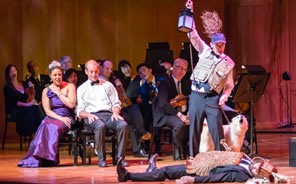
Pyramus (Bottom, aka Cody Nickell) dies under Moonshine (Starveling, aka Spencer Aste) as Hippolyta (Linda Powell), Theseus (John Bolger), and the Baltimore Symphony Orchestra watch. Photo by Kenneth Adam, BSO.
In the middle of all this, Hippolyta suddenly says, "This is the silliest stuff that e'er I heard," which, delivered with perfect timing, can bring the house down—or the symphony hall, for in a Baltimore Symphony Orchestra concert of Felix Mendelssohn's incidental music for the play, a concert that featured actors playing out Shakespeare's scenes, including Pyramus and Thisbe, this line was delivered not by Hippolyta but by the maestro herself, BSO Conductor Marin Alsop, who hitherto hadn't spoken a word as she watched the action from her podium. Pyramus and Thisbe ends with Thisbe's lament and death, which I've seen played as more silliness or as a serious turn, the courtiers suddenly seeing real talent on the stage. Either way, it works, and with a fond farewell to the Rude Mechanicals, the three couples go off to bed.
In Dream, the fairies return to bless the house, while in Hamlet, Fortenbras shows up—yeah, the Norwegian prince who attacked Poland—now in Elsinore to claim the real prize he was after. We come down to the denouement, the final seconds, with Dream and Hamlet still knotted on the scoreboard. Each makes a play for the last shot, and Hamlet throws up a foreign character whose dramatic purpose is to tell us that what we've just seen is a great tragedy and Hamlet likely to have been a great king. Dream has Oberon and Titania leading a dance of fairies, which can be a letdown after the tear-inducing laughter of Pyramus and Thesbe, but it can also be yet more magic, especially as it was done by the STC. Then Puck sticks around to give his epilogue, cementing his and the play's connection with the audience: "If we shadows have offended, think but this, and all is mended, that you have but slumbered here, while these visions did appear."
"Give me your hands, if we be friends," Puck says. In this tight contest the hall has been rocking, but the fans of Dream are infusing that play with even more energy, and Puck's final shot hits its mark. A Midsummer Night's Dream wins this Tournament of Shakespeareances title.
All that's left is to award the tournament's Most Valuable Players, and that honor goes to the Atlanta Shakespeare Tavern production in 1997. Sarah and I hosted my parents and my two sons for this post-Christmas treat at the Tavern, and director Tony Wright had every element of the play—the Rude Mechanicals, the fairies, and even the Athenian lovers—scoring hilarious performances. Stealing the show were three actor/dancers, Angus Whyte, Jody Reynard, and David Craven, who doubled as fairies and Rude Mechanicals. As the former they danced with skill and grace; as the latter, presenting Pyramis and Thisbe, they clumsily tottered across the stage and into the walls like ballet on a bender. By the time Quince screamed at Bottom's Pyramus to die already, I was treated to the indelible image of three generations of Mintons around our table so convulsed in laughter every one of us were wiping tears from our cheeks. It's fair to say that no production in A Midsummer Night's Dream's trek to the tournament title had an answer to this production's contribution to my collective Shakespeareances, not even the "greatest play ever written."
Eric Minton
April 7, 2015
The Brackets
Click on the tournament brackets below to download a PDF version. The play titles on the PDF version are linked to their individual "Productions Seen" page on Shakespeareances.com.
For a tournament overview, click here
For the tournament play-in matches, click here
For results of the First Round matches, click here
For results of the Sweet 16 matches, click here
For results of the Elite Eight matches, click here
For results of the Final Four matches, click here
Comment: e-mail editorial@shakespeareances.com
Start a discussion in the Bardroom



 Find additional Shakespeareances
Find additional Shakespeareances